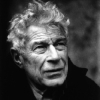John Berger

John Berger
John Peter Bergeris an English art critic, novelist, painter and poet. His novel G. won the 1972 Booker Prize, and his essay on art criticism Ways of Seeing, written as an accompaniment to a BBC series, is often used as a university text...
NationalityEnglish
ProfessionArtist
Date of Birth5 November 1926
stars night sky
Those who first invented and then named the constellations were storytellers. Tracing an imaginary line between a cluster of stars gave them an image and an identity. The stars threaded on that line were like events threaded on a narrative. Imagining the constellations did not of course change the stars, nor did it change the black emptiness that surrounds them. What it changed was the way people read the night sky.
art italian doors
Traditional Chinese art looked at the Earth from a Confucian mountain top; Japanese art looked closely around screens; Italian Renaissance art surveyed conquered nature through the window or door-frame of a palace. For the Cro-Magnons, space is a metaphysical arena of continually intermittent appearances and disappearances.
names needs stories
If every event which occurred could be given a name, there would be no need for stories.
justice littles shouting
Protest and anger practically always derives from hope, and the shouting out against injustice is always in the hope of those injustices being somewhat corrected and a little more justice established.
photograph ifs meaningless
If everything that existed were continually being photographed, every photograph would become meaningless.
reality perspective addresses
The contradiction in perspective was that it structured all images of reality to address a single spectator who, unlike God, could only be in one place at a time.
art creation seeing
All creation is in the art of seeing.
drawing way connections
Drawing is a way of coming upon the connection between things, just like metaphor in poetry reconnects what has become separated.
reality imagination earth
When he painted a road, the roadmakers were there in his imagination, when he painted the turned earth of a ploughed field, the gesture of the blade turning the earth was included in his own act. Whenever he looked he saw the labour of existence; and this labour, recognised as such, was what constituted reality for him. (On Vincent Van Gogh)
sadness men doe
So time doesn't count, and place does?' I said this to tease her. When I was a man, I liked teasing her and she went along with it, consenting, for it reminded us both of a sadness that had passed.
degrees energy appearance
Whenever the intensity of looking reaches a certain degree, one becomes aware of an equally intense energy coming towards one through the appearance of whatever it is one is scrutinizing.
artist drawing intimacy
There's the artist's intimacy and truthfulness to himself, but an equal intimacy to the Other [the one drawn]. Picasso drawings are like that... the Rembrandts are like that. The artist who most often did that was Van Gogh.
drawing people trying
Everything in life, is a question of drawing a life, John, and you have to decide for yourself where to draw it. You cant draw it for others. You can try, of course, but it doesn't work. People obeying rules laid down my somebody else is not the same thing as respecting life. And if you want to respect life, you have to draw a line.
memories stranger photograph
If the public photograph contributes to a memory, it is to the memory of an unknowable and total stranger.